IRIS OF SISSINGHURST BLOG NO.2
AN ITALIAN VET IN KENT
Early Years in Italy
Francesco Bucci was born in Bari, in the Apulia region of southeastern Italy. The Bucci family have lived for many generations in this beautiful part of Italy. This area is not part of traditional tourist itinerary and outside of the main cities and towns, it retains a rural farming economy. Francesco inherited his father and grandfather’s love for the countryside environment, particularly animals and plants. This interest and curiosity about nature was reflected in his academic life and culminated in studying for and obtaining a degree in veterinary medicine.
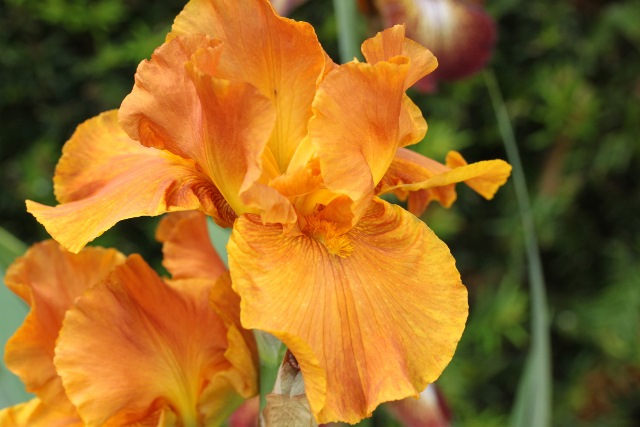 I
I
Iris ‘Brindisi’ named after the port city in Apulia, Italy. Available at Iris of Sissinghurst
Coming to Kent
Career opportunities in the first instance lead to, for experience and employment, a move to northern Italy. This was followed by a couple of years in Australia and New Zealand before the decision to move to the United Kingdom. The decision to relocate to the UK was influenced by work opportunities, the pleasant climate and the quality of life.
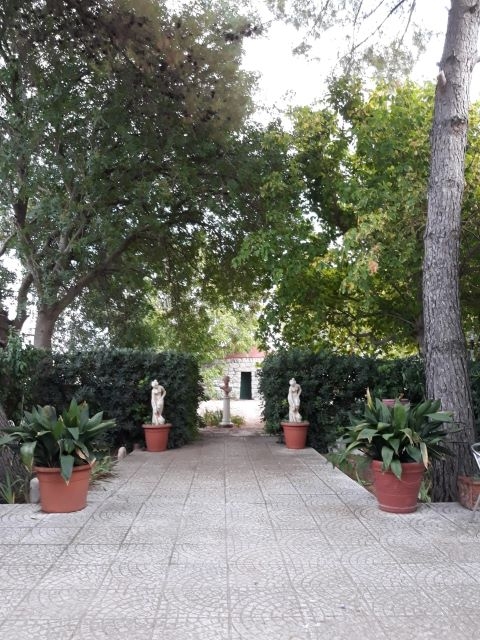
The garden at Francesco’s family home in Italy
Francesco now lives in Ashford, in central Kent. This is ideal for his work as a vet involved in inspecting different work locations to ensure that livestock health, welfare and husbandry standards are being maintained, as well as his work with pets. This is a demanding job and relaxation is important to recharge the batteries and to develop interests outside of employment routines.
One of these interests, plants, as highlighted above, has been a passion since he was a child back in Italy. Both his father and grandfather had a passion for plants and the latter would often be seen with seed/plant catalogues and loved to cultivate unusual crops and ornamental plants. Francesco is the first to admit that he was fortunate to grow up in a family who had inherited a house in the countryside, where he used to spend many summers in his youth. This is because the average Italian family typically live in flats/apartments with very few opportunities to have access to private garden space. This is common to most Mediterranean countries. Flats however often have access to a balcony and it is here that “green fingers” emerge in the use of pots to grow flowers. The most popular plants tend to be geraniums, cyclamen, hibiscus and others that have long blooming seasons, in addition to plants with ornamental foliage such as Aspidistra and Monstera. Great pride is taken in the use of balconies to display plants of particular interest. Gardens, as we understand the term in the UK, are often the preserve of the wealthy in cities. As a result the need for garden plants is limited and therefore nurseries and garden centres are not in huge demand. Can you imagine life in the UK without the obligatory garden centre?
An Interest in Iris
Several Iris species are native to Italy and include both bearded and non-bearded irises. For example, Iris pallida and florentina, well known irises, are found throughout Italy. Iris bicapitata is a bearded iris only found on the Gargano peninsula which is within the Puglia region of Italy. This iris grows at about 700m and above, with a distinct stem bearing two flowers at the head of each – hence the specific name. The flowers are usually violet, but can also be yellow, pure white or grey-white. There are striking bicoloured combinations of violet, yellow, pale blue with a picotee margin. The flowers are fragrant and are reminiscent of roses or violets. The national plant emblem of the country is the Lily although it is often assumed that it is the bearded iris. This is in part because of the historical links in the medieval period to the Medici family and the family emblem which includes an iris.
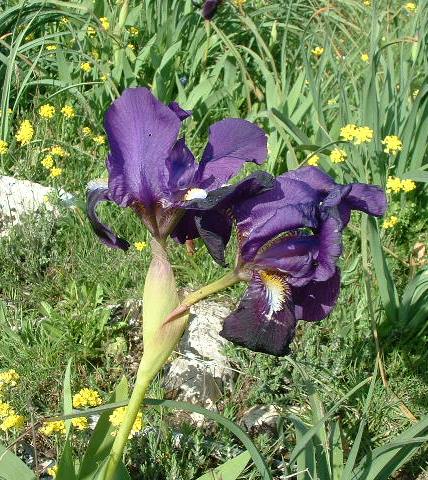
Iris bicapitata
His home in Ashford includes a small garden. The inclusion of a garden was on Francesco’s wish list when viewing properties for sale. The garden is supplemented by the rental of an allotment nearby. However the allotment is not exclusively used for the growing of vegetables and various types of berried fruit but also includes ornamental plants, particularly bearded iris. Francesco started living in Ashford by renting a room, therefore the early visits to garden centres and nurseries tended to focus on the purchase of house plants very popular in Italy, mostly orchids, bromeliads, calatheas and succulents. However, as soon as Francesco was able to buy a house with a garden, irises were some of the first plants to be cultivated, beginning with some rhizomes sent over from his father, who has always loved irises, and then with new irises bought at the Kent Garden Show from us, Iris of Sissinghurst, as well as online from France and USA. A visit to a garden centre or nursery is now part of his everyday routine.
Francesco tries to spend as much time as he can in his garden as well as at the allotment (anyone who has or who has had an allotment will know that allotments are full time jobs to maintain). His father has visited him in the UK and is delighted that Francesco has allowed his childhood interests to be fully developed. It is clear that his father is just a little envious, particularly with the growing of iris, which is obvious when you see him and his son inspecting iris in full bloom. It is also clear that his father is very proud of the achievements of his son. Last year Francesco also started a gardening channel on Youtube, Plant Reviews UK, where several videos about iris varieties and breeding are posted, together with many other garden plants as well as houseplants, the link of the channel is:
https://www.youtube.com/channel/UCv7p_drV2AyZMkt1MZc2-gw
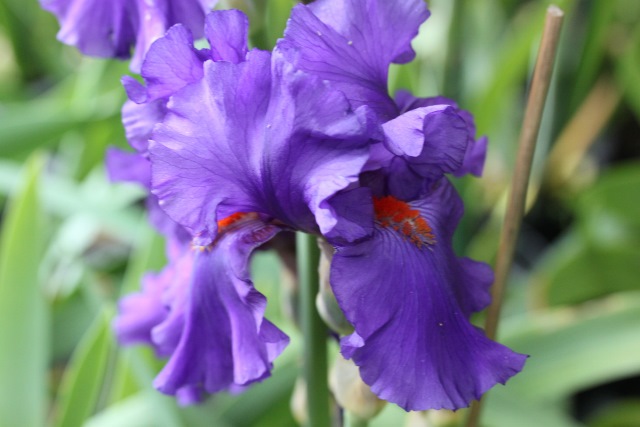
Iris ‘Paul Black’ – available at Iris of Sissinghurst
It Becomes Serious
The growing of irises has become a serious interest. When asked if he has favourites, Francesco tends to prefer bearded iris and mainly the tall varieties. Early interest, as with most hobbies, tends to take in a wide range about the subject but as knowledge and experience is accumulated specialist interest is developed. Whilst difficult to summarise his preferences these can be given as broad headings as follows
1. The colour of a bearded iris is, as a rule, the most important factor. The darker colours of the spectrum are preferred. This would include dark blue, dark purple and black. For example some of his favourite irises are ‘Paul Black’, ‘Local Color’, ‘Devil’s Lake’ and of course ‘Black Suited’, which he fell in love when he first saw the variety at the Kent Garden Show.
2. Matching colours of the standards (petals) and falls (sepals) are preferred to bi-colours (those iris which have different colours for the standards (petals) and falls (sepals)). Also, a beard contrasting with the colour of the petal is very much appreciated e.g. ‘Dracula’s Kiss’, ‘Paul Black’, ‘Local Color’, and two beautiful intermediate irises, ‘Imperative’ and ‘Devil May Care’.
3. Broken pattern iris (these are like marmite with a split view on likeability) as well as strong veining on both standards (petals) and falls (sepals). This is a very rare pattern in common bearded irises, so Francesco owns a small collection of species that develop this kind of pattern on the flowers (e.g. Iris stolonifera, Iris iberica, Iris lineolata), hoping to be able to hybridize them with the common bearded irises in order to develop a strong veining in the flower.
4. There is, in general, a preference for those iris bred from the late 1980s to the present. These tend to be taller, flower longer and have an increased range of colours. (NOTE a future blog will focus on how the bearded iris has evolved as a result of breeding over the last 100 years, for example ‘Quaker Lady’ (1909) to ‘High Chaparral’ (2006)).
5. Whilst favouring “modern” iris the classical shape of the falls is preferred. For example ‘Kent Pride’.

Iris stolonifera
NOTE some of you will be surprised that there is not a reference to the importance of fragrance to a variety. This despite the fact that the iris is famous for its use in the production of perfumes. In fact, Francesco always tests the fragrance of flowers but takes the view that we all have different abilities to smell and that he generally cannot detect sharp differences between varieties although other people probably can. Francesco states that his nose is probably not trained enough to distinguish between the fragrance of different irises. He does, however, recommend two varieties that have beautiful scent. These are ‘Poem Of Ecstasy’ and ‘Paul Black’.
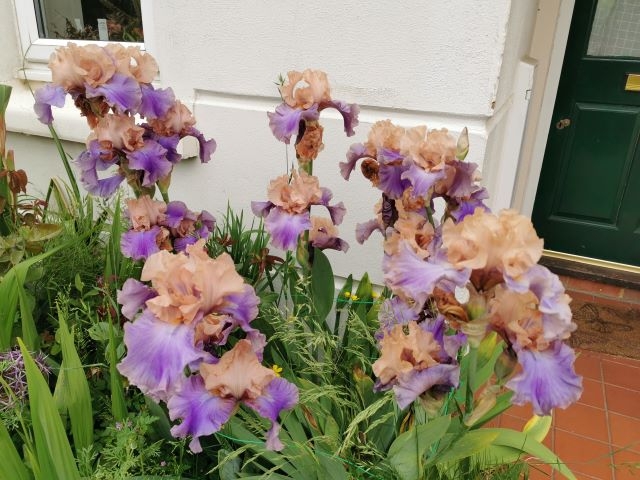
Iris ‘Poem of Ecstasy’ one of the first irises Francesco bought from us at Iris of Sissinghurst
How About Breeding Your Own
The above preferences do cause some frustrations. Francesco is clear about what features of an iris are most attractive to him, but these are not always readily available. A solution to that is to consider creating your own iris through breeding (hybridising). (NOTE this blog is not the best place to describe the breeding process and a future blog will attempt to describe the process).
The aim of hybridising is to create a seedling which will have a colour and shape that matches your aspirations. This means preselecting the two existing varieties (parents) to be used, to create a variety with a particular colour/colours and shape and fragrance. There is, of course, an element of trial and error with no certainty that the outcome will match expectations.
In the case of Francesco he has a particular interest in the darker colours with a bright contrasting beard. His holy grail is a true black iris. Good luck!!!

Seedlings…what will the future hold for these little ones…
You Can Do It
In the main Francesco has been self-taught. He has had the opportunity to discuss hybridisation with Brian Hersey, a highly respected Kent expert, and has received some valuable advice on techniques. The one big piece of advice or experience given was to START EARLY. I think this relates to the fact that from selecting the pollen, picking the seeds, growing the plants, selecting the most promising, trialling the variety for sustainability to its naming can take 10 years. Of course you are able to go from a seed to flowering within approximately three years. If you are able to breed an iris to your liking, you can put forward the iris to the British iris Society to obtain a name for that iris. There is a small fee involved and there are some simple rules about what names you can choose but many iris lovers, amateur growers, do this.
I hope, in reading this story, you will be inspired to copy Francesco. Anyone can do it!!!!!
Other irises mentioned in the blog that are available from us at Iris of Sissinghurst:
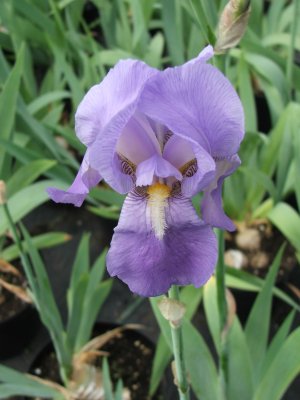
Iris pallida

Iris ‘Local Color’
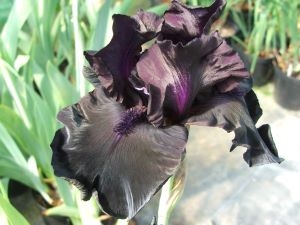
Iris ‘Black Suited’

Iris ‘Imperative’

Iris ‘Quaker Lady’

Iris ‘High Chaparral’
